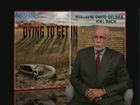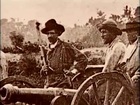Browse Titles - 60 results
60 Minutes, How Secure Is Your Airport?
produced by L. Franklin Devine, fl. 1993-2016, Trevor Nelson and Graham Messick, fl. 2000-2016, Columbia Broadcasting System; interview by Steve Kroft, 1945-, in 60 Minutes (New York, NY: Columbia Broadcasting System, 2001), 12 mins
The fact that security there was lax has been an open secret for many years - just how lax is a scandal. Government study after government study, test after test, report after report demonstrated conclusively that security at America's airports was hopelessly ineffective. Steve Kroft reports.
Sample
produced by L. Franklin Devine, fl. 1993-2016, Trevor Nelson and Graham Messick, fl. 2000-2016, Columbia Broadcasting System; interview by Steve Kroft, 1945-, in 60 Minutes (New York, NY: Columbia Broadcasting System, 2001), 12 mins
Description
The fact that security there was lax has been an open secret for many years - just how lax is a scandal. Government study after government study, test after test, report after report demonstrated conclusively that security at America's airports was hopelessly ineffective. Steve Kroft reports.
Date Written / Recorded
2001-09-16
Field of Study
Media Studies
Content Type
News story
Contributor
L. Franklin Devine, fl. 1993-2016, Trevor Nelson, Graham Messick, fl. 2000-2016, Columbia Broadcasting System
Author / Creator
Steve Kroft, 1945-
Date Published / Released
2001-09-16
Publisher
Columbia Broadcasting System
Series
60 Minutes
Person Discussed
Danilo Orculo, fl. 2001, Kevin McCree, fl. 2001, Dan Bolshie, fl. 2001, Alexis Stefani, fl. 2001, Steve Elson, fl. 1999
Topic / Theme
Checkpoints, Terrorism, Public safety, Airports, Security personnel, War and Violence
Copyright Message
Copyright © 2001 by Columbia Broadcasting System
×
60 Minutes, Dying To Get In
produced by David Gelber, fl. 1991-2014 and Joel Bach, fl. 2005-2014, Columbia Broadcasting System; interview by Ed Bradley, 1941-2006, in 60 Minutes (New York, NY: Columbia Broadcasting System, 2006), 13 mins
This segment documents the problems the U.S. encounters trying to prevent illegal immigrants from entering the country from its southern borders. Ed Bradley reports.
Sample
produced by David Gelber, fl. 1991-2014 and Joel Bach, fl. 2005-2014, Columbia Broadcasting System; interview by Ed Bradley, 1941-2006, in 60 Minutes (New York, NY: Columbia Broadcasting System, 2006), 13 mins
Description
This segment documents the problems the U.S. encounters trying to prevent illegal immigrants from entering the country from its southern borders. Ed Bradley reports.
Date Written / Recorded
2006-06-04
Field of Study
Media Studies
Content Type
News story
Contributor
David Gelber, fl. 1991-2014, Joel Bach, fl. 2005-2014, Columbia Broadcasting System
Author / Creator
Ed Bradley, 1941-2006
Date Published / Released
2006-06-04
Publisher
Columbia Broadcasting System
Series
60 Minutes
Person Discussed
Wayne A. Cornelius, fl. 1979, Tom Tancredo, 1945-, T. J. Bonner, fl. 2006, Mark Reed, 1957-, Bruce Parks, fl. 2006, Garrett Neubauer, fl. 2006
Topic / Theme
Death, Government policy, Crossing borders, Immigrant populations, Immigration laws, Immigration and emigration, Migration and Diaspora
Copyright Message
Copyright © 2006 by Columbia Broadcasting System
×
60 Minutes, Screening The TSA
produced by Karen M. Sughrue, fl. 2006-2013, Columbia Broadcasting System, in 60 Minutes (New York, NY: Columbia Broadcasting System, 2009), 13 mins
Are the hassles passengers endure at airport security checkpoints really making them safer? The TSA says they are, but a security adviser who has advised them says those measures are 'security theater.' Lesley Stahl reports.
Sample
produced by Karen M. Sughrue, fl. 2006-2013, Columbia Broadcasting System, in 60 Minutes (New York, NY: Columbia Broadcasting System, 2009), 13 mins
Description
Are the hassles passengers endure at airport security checkpoints really making them safer? The TSA says they are, but a security adviser who has advised them says those measures are 'security theater.' Lesley Stahl reports.
Field of Study
Media Studies
Content Type
News story
Contributor
Karen M. Sughrue, fl. 2006-2013, Columbia Broadcasting System
Author / Creator
Lesley Stahl, 1941-
Date Published / Released
2008-08-02, 2009-08-02
Publisher
Columbia Broadcasting System
Series
60 Minutes
Topic / Theme
Terrorism, Airports, Checkpoints, War and Violence
Copyright Message
Copyright © 2009 by Columbia Broadcasting System
×
60 Minutes, Watching the Border
produced by Keith Sharman, fl. 2006-2013, Columbia Broadcasting System, in 60 Minutes (New York, NY: Columbia Broadcasting System, 2010), 14 mins
January 10, 2010, 8:00 PM-Steve Kroft reports on the status of the multi-billion-dollar "virtual fence" being built at the U.S.-Mexican border, which is behind schedule and so far covers only about one percent of the border.
Sample
produced by Keith Sharman, fl. 2006-2013, Columbia Broadcasting System, in 60 Minutes (New York, NY: Columbia Broadcasting System, 2010), 14 mins
Description
January 10, 2010, 8:00 PM-Steve Kroft reports on the status of the multi-billion-dollar "virtual fence" being built at the U.S.-Mexican border, which is behind schedule and so far covers only about one percent of the border.
Field of Study
Media Studies
Content Type
News story
Contributor
Keith Sharman, fl. 2006-2013, Columbia Broadcasting System
Author / Creator
Steve Kroft, 1945-
Date Published / Released
2010-01-10
Publisher
Columbia Broadcasting System
Series
60 Minutes
Topic / Theme
Mexico and the United States Border, Immigration and emigration, Law enforcement, Crossing borders, Political boundaries, Science and Technology, Migration and Diaspora, Politics & Policy, 21st Century in World History (2001– ), 20th Century in World History (1914--2000)
Copyright Message
Copyright © 2010 by Columbia Broadcasting System
×
60 Minutes, The All-American Canal
produced by Shawn Efran, fl. 2004-2016, Columbia Broadcasting System, in 60 Minutes (New York, NY: Columbia Broadcasting System, 2010), 12 mins
The most dangerous body of water in the U.S. is a deep canal on the Mexican border with California where over 550 people, mostly illegal immigrants, have drowned. Scott Pelley reports.
Sample
produced by Shawn Efran, fl. 2004-2016, Columbia Broadcasting System, in 60 Minutes (New York, NY: Columbia Broadcasting System, 2010), 12 mins
Description
The most dangerous body of water in the U.S. is a deep canal on the Mexican border with California where over 550 people, mostly illegal immigrants, have drowned. Scott Pelley reports.
Field of Study
Media Studies
Content Type
News story
Contributor
Shawn Efran, fl. 2004-2016, Columbia Broadcasting System
Author / Creator
Scott Pelley, 1957-
Date Published / Released
2010-05-02
Publisher
Columbia Broadcasting System
Series
60 Minutes
Topic / Theme
Crossing borders, Canals, Immigration and emigration, Migration and Diaspora, Mexicans
Copyright Message
Copyright © 2010 by Columbia Broadcasting System
×
60 Minutes, Chaos On The Border
presented by Scott Pelley, 1957-; produced by Oriana Zill de Granados, fl. 2009-2015 and Michael Rey, fl. 2009; interview by Scott Pelley, 1957-, in 60 Minutes (New York, NY: Columbia Broadcasting System (CBS), 2018), 13 mins
A report on the separation of migrant families from their children at the U.S. Mexico border under President Donald Trump's immigration policy. An internal document reveals that border control stations made no effort to identify or reunite families prior to their removal from the country. Agencies struggled to pro...
Sample
presented by Scott Pelley, 1957-; produced by Oriana Zill de Granados, fl. 2009-2015 and Michael Rey, fl. 2009; interview by Scott Pelley, 1957-, in 60 Minutes (New York, NY: Columbia Broadcasting System (CBS), 2018), 13 mins
Description
A report on the separation of migrant families from their children at the U.S. Mexico border under President Donald Trump's immigration policy. An internal document reveals that border control stations made no effort to identify or reunite families prior to their removal from the country. Agencies struggled to provide reliable data on family separations and that child separation began nine months earlier than the government acknowledged.
Include...
A report on the separation of migrant families from their children at the U.S. Mexico border under President Donald Trump's immigration policy. An internal document reveals that border control stations made no effort to identify or reunite families prior to their removal from the country. Agencies struggled to provide reliable data on family separations and that child separation began nine months earlier than the government acknowledged.
Includes interviews with: Ever, migrant father of a detained child; Scott Shuchart, former employee, Office of Civil Rights and Civil Liberties, Homeland Security; Cecilia Munoz, former Director of Domestic Policy Council; Dr. Pam McPherson, psychiatrist, Homeland Security, and Dr. Scott Allen, internist, Homeland Security; Gladys, mother of a detained child; Lee Gelernt, attorney, ACLU.
Show more
Show less
Field of Study
American History
Content Type
News story, Interview
Contributor
Oriana Zill de Granados, fl. 2009-2015, Michael Rey, fl. 2009
Author / Creator
Scott Pelley, 1957-
Date Published / Released
2018
Publisher
Columbia Broadcasting System (CBS)
Series
60 Minutes
Person Discussed
Lee Gelernt, Cecilia Muñoz, 1962-, Donald Trump, 1946-
Topic / Theme
Family separation, Immigrant life, Immigration laws, Immigration and emigration, Crossing borders, Migration and Diaspora, Early 21st Century United States (2001– ), 21st Century in World History (2001– )
Copyright Message
Copyright © 2018 CBS Broadcasting Inc. All Rights Reserved.
×
60 Minutes, Spilling Across The Border
presented by Lesley Stahl, 1941-; produced by Natalie Jimenez Peel, fl. 2012 and Shachar Bar-On, fl. 1992; interview by Scott Pelley, 1957-, in 60 Minutes (New York, NY: Columbia Broadcasting System (CBS), 2020), 13 mins
A report on the presence of raw sewage in Southern California’s oceans that has spread from nearby Tijuana, Mexico. Communities on both sides of the border are at risk due to the contaminated water, though few precautions have been taken to assure safety. Includes interviews with Amber Craig, a border patrol age...
Sample
presented by Lesley Stahl, 1941-; produced by Natalie Jimenez Peel, fl. 2012 and Shachar Bar-On, fl. 1992; interview by Scott Pelley, 1957-, in 60 Minutes (New York, NY: Columbia Broadcasting System (CBS), 2020), 13 mins
Description
A report on the presence of raw sewage in Southern California’s oceans that has spread from nearby Tijuana, Mexico. Communities on both sides of the border are at risk due to the contaminated water, though few precautions have been taken to assure safety. Includes interviews with Amber Craig, a border patrol agent; Fay Crevoshay, an environmentalist with Wildcoast; Mark West, retired Naval Officer; Alex Lopez, Kyle Buckett, Bill Lyman, and Stev...
A report on the presence of raw sewage in Southern California’s oceans that has spread from nearby Tijuana, Mexico. Communities on both sides of the border are at risk due to the contaminated water, though few precautions have been taken to assure safety. Includes interviews with Amber Craig, a border patrol agent; Fay Crevoshay, an environmentalist with Wildcoast; Mark West, retired Naval Officer; Alex Lopez, Kyle Buckett, Bill Lyman, and Steve Viola, retired SEALs; and Serge Dedina, mayor of Imperial Beach, California and executive director of Wildcoast.
Show more
Show less
Field of Study
Environmental Studies
Content Type
Interview, News story
Contributor
Natalie Jimenez Peel, fl. 2012, Shachar Bar-On, fl. 1992
Author / Creator
Scott Pelley, 1957-, Lesley Stahl, 1941-
Date Published / Released
2020
Publisher
Columbia Broadcasting System (CBS)
Series
60 Minutes
Person Discussed
Serge Dedina, 1964-
Topic / Theme
Environmental impact analysis, Water pollution, Drainage basins, Sewage disposal, Oceanography, Urban sanitation, Smuggling, Crossing borders, Climate and the Environment, Early 21st Century United States (2001– )
Copyright Message
Copyright © 2020 CBS Broadcasting Inc. All Rights Reserved.
×
Chapter 2: A Transplantation to the North
written by Carter Godwin Woodson, 1875-1950 (1918); in A Century of Negro Migration (District of Columbia: Association for the Study of Negro Life and History (ASNLH), 1918), 24-44
Sample
written by Carter Godwin Woodson, 1875-1950 (1918); in A Century of Negro Migration (District of Columbia: Association for the Study of Negro Life and History (ASNLH), 1918), 24-44
Date Written / Recorded
1918
Field of Study
Black Studies
Content Type
Chapter
Author / Creator
Carter Godwin Woodson, 1875-1950
Date Published / Released
1918
Publisher
Association for the Study of Negro Life and History (ASNLH)
Topic / Theme
Free states, Freed slaves, Fugitive slaves, Slave resettlement, Politics, Agriculture
×
Discussion of John Brown in North Elba, NY and "Bleeding Kansas," 1854
in The Conflict Begins, Disc 1, Civil War Journal (New York, NY: A&E Television Networks, 1993, first release 2001), 7 mins
The History Channel's acclaimed series, Civil War Journal, takes viewers beyond the battles and into the personal stories of the War Between the States. Drawing on diaries, photographs and dramatic re-enactments, the intimate side of the epic conflict is exposed. In this gripping, 2 DVD set, the earliest days of t...
Sample
in The Conflict Begins, Disc 1, Civil War Journal (New York, NY: A&E Television Networks, 1993, first release 2001), 7 mins
Description
The History Channel's acclaimed series, Civil War Journal, takes viewers beyond the battles and into the personal stories of the War Between the States. Drawing on diaries, photographs and dramatic re-enactments, the intimate side of the epic conflict is exposed. In this gripping, 2 DVD set, the earliest days of the war come alive through four favorite episodes: John Brown's War, Destiny at Fort Sumter, The Battle of 1st Bull Run, The 54th Massac...
The History Channel's acclaimed series, Civil War Journal, takes viewers beyond the battles and into the personal stories of the War Between the States. Drawing on diaries, photographs and dramatic re-enactments, the intimate side of the epic conflict is exposed. In this gripping, 2 DVD set, the earliest days of the war come alive through four favorite episodes: John Brown's War, Destiny at Fort Sumter, The Battle of 1st Bull Run, The 54th Massachusetts.
Show more
Show less
Field of Study
The American Civil War
Content Type
Documentary
Date Published / Released
2001, 1993
Publisher
A&E Television Networks
Series
Civil War Journal
Person Discussed
John Brown, 1800-1859
Topic / Theme
Abolitionism, Free states, Massacres, Bleeding Kansas, 1854-1859, American History, Civil War (1860–1865), Industrialization and Western Global Hegemony (1750–1914)
Copyright Message
Copyright 2008 A&E Television Networks
×
Chapter 10: Educating Negroes Transplanted to Free Soil
written by Carter Godwin Woodson, 1875-1950 (1919); in The Education of the Negro Prior to 1861: A History of the Colored People of the United States from the Beginning of Slavery to the Civil War (District of Columbia: Associated Publishers, 1919), 234-260
Sample
written by Carter Godwin Woodson, 1875-1950 (1919); in The Education of the Negro Prior to 1861: A History of the Colored People of the United States from the Beginning of Slavery to the Civil War (District of Columbia: Associated Publishers, 1919), 234-260
Date Written / Recorded
1919
Field of Study
Black Studies
Content Type
Chapter
Author / Creator
Carter Godwin Woodson, 1875-1950
Date Published / Released
1919
Publisher
Associated Publishers
Person Discussed
Henry Bibb, 1815-1854
Topic / Theme
Free states, Freed slaves, Politics, Agriculture
×









